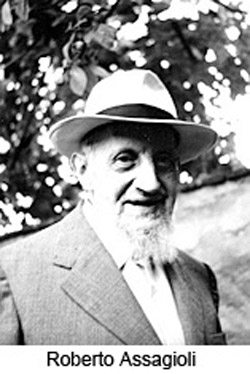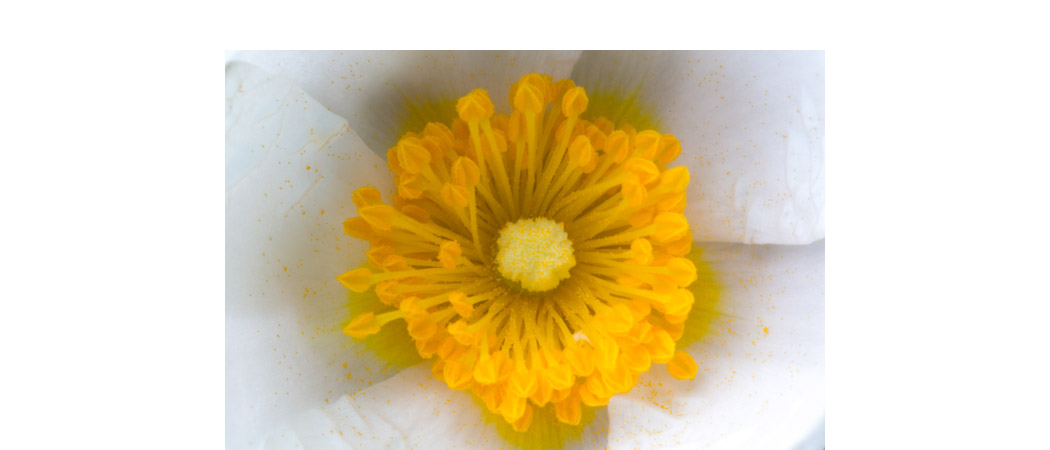I first met Roberto Assagioli, the founder of Psychosynthesis, in 1969. I had returned from an extended stay in California, which in those days was a forge of new ideas - among them, those that most interested me: realization of one's own potential, transpersonal psychology, altered states of consciousness. I had spent some time at Esalen Institute, epicentre of all the research and activity on these themes. There, I had heard talk of the Italian psychiatrist Roberto Assagioli as an important figure in this field: "What! You're Italian and you don't even know him? He lives in Florence.".
When I returned to Italy, I wrote to him, then went to visit him. The night before, although I had never seen him in person nor in photograph yet, I dreamt him: a thin, smiling elderly man, with white beard, and the air of a wise rabbi. He was in the back seat of an impressive, luxury-model car. He said: "Come, I'll take you for a ride." The next day I met Assagioli. He was just like the character of my dream. Thus I decided to go for a ride with him. The ride on which he took me was a profound inner transformation and an extraordinary broadening of my perspectives.
These were normal experiences for anyone who worked with him. You had strange dreams that were beautiful and intense, and sudden inner transformations, weird coincidences, sensations and feelings previously unknown. You could really see what change was.
And yet Assagioli was no guru or wizard. On the contrary: he belonged to the best scientific and cultural tradition of the early twentieth century. He had written for Prezzolini's authoritative journal La Voce, had been a friend of Jung, and Freud himself regarded him as the representative of Psychoanalysis in Italy – not surprisingly, as he was the first to translate and publish psychoanalytic work into Italian. He had rubbed elbows with people like Martin Buber and Rabindranath Tagore, D.T. Suzuki and Inhayat Khan. Most important of all, he had founded psychosynthesis, a school of psychology with vastly stimulating ideas for people concerned with personal transformation.
Just before Assagioli died, a strange coincidence occurred. I was once more in California, in Los Angeles. By chance I met a man who told me he knew Assagioli. He had met him a few years before. He had gone to his place, where Assagioli had him sit for a few minutes in a small waiting room. Then Assagioli's house-keeper led him to another room, and, giving him pen and paper, said: "Doctor Assagioli would like you to make a list of everything you saw in the first room – every object, painting, and so on." It was an exercise in observation, very useful for those who live too much in their feelings and forget their hold on reality. Just as this man was telling me the story, Assagioli, unbeknown to me, was dying in his country house at Capolona.
This observation exercise may seem a curiosity, a simple exercise. But the underlying concept is basic. Psychosynthesis aims at mastery of all our psychic functions. How can we feel well if we have no control over ourselves, if we cannot use to advantage the instruments we have been given?
In this work the role of the will is essential. Assagioli retrieved it from the limbo to which psychoanalysis had relegated it. It is a renewed will: nothing to do with victorian willpower or authoritarianism, but will as mastery of oneself and the capacity to act in the world rather than be victim of circumstance – the common complaint of all neurotics.
Perhaps the most striking theme of psychosynthesis is the superconscious: the origin of our best intuitions, the most beautiful moments of our life, our higher sentiments such as joy, peace, unconditional love, and our creative ideas. To encourage access to the superconscious, psychosynthesis offers various practical techniques, based on visualization, inner silence and meditation.
Assagioli differentiates the higher unconscious from the middle unconscious - the stuff of which we are not always aware, but which is accessible, for example our telephone number, or the memory of what we did last summer - and from the lower unconscious, seat of impulses and instincts, the part of us that represents the beginnings of our evolution. This division between lower and higher is sometimes unjustly seen as an attempt to smuggle into psychology a subtle moralising attitude. But no. "Inferior" only means "earlier in our evolution ".
Yet I had difficulty with this apparent dichotomy. Assagioli gave me the following image: "We are like a lotus, whose beauty and perfume are clearly perceptible by all, and whose roots are sunk in the mud". Seeing as I used to enjoy an argument, I immediately grabbed the opportunity: "There's the moralising!, the spirit is a beautiful flower, but instincts, sexuality, the body, are the mud." One-nill to me, I thought. But I was wrong. Assagioli's reply was enlightening: "Not at all. You are the moralist. You think mud is dirty and ugly. For me, mud is alive and fertile, intimately connected with the flower. Without the mud the lotus would not live and grow."
And now let us go back to Assagioli's waiting room. There was a divan with a garnet-coloured silk blanket on it, and Sanskrit writing embroidered in gold. A label gave the translation: "As people come to me, so do I receive them". It is a verse from the Bhagavad Gita, the sacred Indian text. It is Krishna speaking, symbol of the spiritual Self. And he tells us that the ways to him are many.
Some can realize themselves through dance, others through meditation, some through work and immersing themselves in society, others through the contemplation of beauty, some in scientific research and philosophy, others through prayer. This too was a notion dear to Assagioli: the ways to our true Self (or transpersonal Self, as he liked to call it) are many. There are no dogmas, no monopolies, no compulsory paths.
The work on oneself is not a form of solitary entertainment. Assagioli always gave much importance to relations between people. Our balance and well-being depend on the nature of our relationships with others: We carry in us unresolved conflicts, resentments, bad memories. On the other hand, if our relations with others are serene and harmonious, we will feel better. Love, kindness, serenity, openness, and other interpersonal qualities can be cultivated. We can realize ourselves in relating with others.
After about a year of working with Assagioli, I thought I understood that the techniques of psychosysnthesis were not so important, and that what really counted was the relation between therapist or counselor and client, the alchemy that happens between these two people. I told Assagioli in rather a sharp way: "Techniques are useless. What counts is relationship." There was a bit of malice and presumption in this statement – after all, psychosynthesis is full of techniques. I thought I would catch Assagioli unawares. But I did not. His answer came straightaway: "At last you got it! I was wondering how long it would take you."
Assagioli was also one of the first to regard beauty as a basic human experience. It is unusual for psychology to speak of beauty. For him it was a central theme. He spoke of a Way of beauty, which leads to the realisation of the Self, and whose basic ingredient is the sense of revelation and fullness that beauty can offer. But in psychosynthesis beauty in all its forms is considered worthy of attention, because it is formative. When meeting a psychotherapy client, Assagioli would want to know what were his favourite films, paintings, books, music. Beauty heals us, changes us, teaches us. This view of Assagioli's is behind the book I have written on beauty, and I am grateful to him for having shown me this new and essential perspective.
Has Assagioli communicated with any of his pupils since his death? After all, he was in the business, given that he was one of the first in Italy to be interested in parapsychology, leaving that field of research behind only in order to concentrate on psychosynthesis. I have always been rather sceptical about communication with the beyond. But a curious event occurred, and it struck me.
Assagioli had been dead some months and had left a big void in his students and collaborators. I was talking with a woman who had met him once. In mentioning the conversation she had had with him, she said that Assagioli had advised her to read Emerson's essay on self-reliance. She explained that in this essay Emerson talks about the importance of following one's own ideas and experience rather than leaning on what authorities, wise people, or great thinkers say. Whatever issues from us is more authentic, it is first-hand, and has more value than anything inherited from someone else. In that moment I had the precise and intense feeling that Assagioli was communicating with me, was telling me: now you are on your own, trust yourself. What better last teaching could a great master give?

PSYCHOSYNTHESIS: A SHORT BIBLIOGRAPHY
R. Assagioli. (1965) Psychosynthesis: A manual of principles and techniques. New York: Viking Press.
R. Assagioli. (1974) The Act of Will. New York: Penguin
R. Assagioli. (1991) Transpersonal Development. London: Crucible/Harper Collins.
Brown, M.Y. (2009). Growing Whole: Self-Realization for the Great Turning. Mt. Shasta, CA: Psychosynthesis Press.
Brown, M.Y. (2004). The Unfolding Self. New York: Helios Press.
Brown, M.Y., and Macy, J. (2014). Coming Back to Life. Gabriola: New Society.
Ferrucci, P. (2007) The Power of Kindness. New York: Tarcher.
Ferrucci, P. (1983). What We May Be. New York: Tarcher.
Ferrucci, P. (1989). Inevitable Grace. New York: Tarcher.
Ferrucci, P.(2009). The Soul of Beauty. New York: Tarcher.
Ferrucci, P. (2014). Your Inner Will. New York: Tarcher.
Firman, J. and Gila, A. (1997). The Primal Wound. New York:State University of New York Press.
Firman, J. and Gila, A. (2002). Psychosynthesis: A Psychology of Spirit. Albany, NY: State University of New York Press.
Firman, J. and Gila A. (2007). Assagioli's Seven Core Concepts for Psychosynthesis training. Palo Alto. CA: Psychosynthesis Palo Alto.
Hardy, J. (1996). A Psychology with a Soul. London: Woodgrange Press.
Horowitz, M. (2014). The Dance of We. Amherst: Synthesis Press.
Kramer, S. (1995). Transforming the Inner and Outer Family. New York: The Haworth Press.
Parfitt, W. (1990). The Elements of Psychosynthesis. Shaftesbury: Element Books Ltd.
Parfitt, W. (2006). Psychosynthesis: The Elements and Beyond. PS Avalon.
Whitmore, D. (1986). Psychosynthesis Counselling in Action. Sage Publications.
Yeomans, Th. Soul on Earth: Readings in Spiritual Psychology. Concord, Mass. Concord Institute.
For information on psychosynthesis activities and publications in the U.S. and worldwide, see http://aap-psychosynthesis.org
